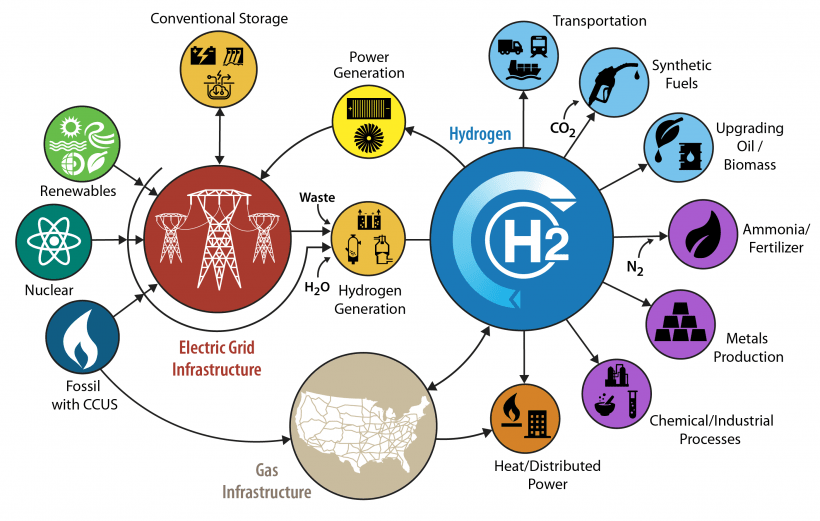This week, pv magazine USA, which offers daily updates on the solar industry, reported that the Biden administration is forming a Hydrogen Interagency Task Force to be jointly led by the Department of Energy and the White House Office of Domestic Climate Policy. According to Mary Frances Repko, the White House deputy national climate advisor, the purpose of the task force is to leverage the strengths of the US government to build the green hydrogen economy. Hydrogen has two major connections to PV solar technology. First, among the cleanest ways to produce hydrogen is via solar-powered electrolysis, where an electric current generated by PV cells drives a chemical reaction that splits water (H2O) into hydrogen (H2) and oxygen (O2). Second, hydrogen can help solve the problem posed by the intermittency of sunlight, which creates the need for energy storage to grow simultaneously with solar PV. Today natural gas essentially functions as the grid’s most prominent energy storage device, since it is a potent, easily obtained source of chemical energy that can be moved around and burned when needed to drive electric generators. But hydrogen has the potential to play precisely the same role – with the great benefit, of course, that burning it to make electricity simply regenerates the water molecule, with no carbon dioxide emissions.
Most climate and energy analysts think of green hydrogen as an “emerging” technology – not yet ready for prime time, but with substantial promise to drive future emissions reductions. It is not easy to know, however, precisely what roles hydrogen is best suited for in a decarbonized economy. One challenge in thinking clearly about hydrogen is that it is both an energy source to power processes like electricity generation, and an essential ingredient to manufacture necessary commodities. On the energy side, because hydrogen burns with a very hot flame, it is well suited to replace natural gas in providing the intense heat needed to fire industrial processes like cement and glassmaking. And while EVs have won the day with cars and light trucks, long-haul trucking, shipping and aviation remain as plausible important niches for the direct use of hydrogen in transportation. On the commodity side, hydrogen is a crucial ingredient that goes into the manufacture of fertilizers, steel and methanol. It is also central to petroleum refining, where it is combined with crude oil to generate plastics, asphalt and petrochemicals.
Back in 2003, President George W. Bush famously stated that hydrogen would be the promising fuel of the future because it is easily available “right in our backyard”. Actually, the hydrogen molecule (H2) is found in only trace amounts in Nature, making it (like electricity) an energy carrier rather than a primary energy source. So the big issue with respect to hydrogen’s role in the green economy is how to manufacture it without causing more climate pollution than it solves. Today almost all of the 10 million tons of hydrogen produced annually in the US is made by a process called steam methane reforming, which involves heating natural gas in the presence of water to yield the hydrogen together with carbon dioxide. One way to fix this is to install carbon capture and storage (CCS) equipment in the manufacturing plant, creating so-called “blue” hydrogen that is decarbonized to the extent that the CO2 is prevented from escaping. The better but more expensive approach is to make “green” hydrogen via electrolysis powered by renewable energy like sunlight. Not making decarbonized hydrogen at all, however, is not an option – because we will always need a stable, energy-rich molecule that burns to generate industrial heat and can be used to make other energy-rich commodities like fertilizers. Absent fossil fuels, the only other possibility is biomass, which, needless to say, has its own role in Earth’s healthy climate system and cannot be relied on as a major energy source.
The new Hydrogen Interagency Task Force is expected to lead the transformation of industrial hydrogen into a green commodity able to claim its proper place in the decarbonized future economy. It will follow a new National Clean Hydrogen Strategy and Roadmap that the Biden administration issued a few months ago. The Roadmap relies in good measure on $9.5 billion of funding from 2021’s Bipartisan Infrastructure Bill, of which $8 billion goes to build regional Clean Hydrogen Hubs that the DOE will announce this Fall. Generous tax breaks written into last year’s Inflation Reduction Act also incentivize the nascent decarbonized hydrogen industry, with larger tax breaks going to manufacturers that reduce carbon dioxide emissions by greater amounts. Both of these outlays are intended to catalyze private investment, essential if the industry is to grow. It will be important for the federal government to do what it can to encourage downstream use of decarbonized hydrogen in transportation and industries where it works well – avoiding the temptation to use it in sectors where electricity is better suited and already has a big head start, such as light vehicles and space or hot water heating in homes and businesses. Investments in hydrogen infrastructure targeted to such inappropriate applications would be a mistake and might well end up as stranded assets.
The fact that hydrogen is so embedded in the current fossil-fuel dominated energy system is causing a great deal of heartburn for progressive organizations that seek an energy transition true to the principles of environmental justice, where a key issue is the location of vulnerable communities adjacent to polluting factories. What these groups fear is that the emphasis on decarbonizing hydrogen is little more than a smokescreen to perpetuate the fossil fuel industry. It is not hard to see why: if “clean” hydrogen is still going to be combined with crude oil to make plastics, then the oil extraction industry and petrochemical factories will continue to operate. And if hydrogen manufacturing is made “clean” through carbon capture, then it is helping to build a CCS industry that, in their view, will perpetuate coal and natural gas use well into the future. These concerns were prominent in an announcement this week from the Center for Biological Diversity, Food & Water Watch and the Michigan Environmental Justice Coalition, supporting a national coalition of more than 180 conservation and social justice organizations in their demand that the Biden administration cancel all funding for the Clean Hydrogen Hubs.
The coalition letter raises legitimate concerns around the construction of a hydrogen infrastructure network, which is challenging because it is not easily interchangeable with the network of pipelines and hubs supporting natural gas, and because the intrinsic properties of hydrogen as an element lead to embrittlement of metal pipelines. Given the highly combustible nature of the fuel, concerns about safety are also well-founded and will need to be addressed. However, other statements in the letter are not grounded in reliable science. Hydrogen production does not make excessive demands on fresh water supplies: a report from the Rocky Mountain Institute details the water requirements for “blue” and “green” hydrogen, which are roughly equivalent to each other and substantially lower than the water demand for coal or nuclear power. Similarly, hydrogen’s potential to indirectly cause global warming is projected to be very small compared to the burden imposed by carbon dioxide, and does not raise the significant concern implied in the letter.
The main problem with the coalition’s letter, though, is that it fails to grapple with the reality of our present and future needs for hydrogen, instead criticizing even green hydrogen as a plausible path forward. Such an extreme position is at sharp odds with the unanimous Democratic vote in favor of the Inflation Reduction Act, which enacted tax breaks for both blue and green hydrogen. The credibility of the coalition and its effectiveness in advocating for environmental justice would be much better served by dropping unfounded arguments and joining the science-based discussion. For example, a major unresolved issue concerns whether investments in blue hydrogen are a good idea. Critics of blue hydrogen point out that it will never be possible to capture all of the carbon dioxide from the smokestacks, and rightly emphasize that upstream methane emissions from the natural gas pipelines make sizable contributions to the greenhouse pollution. However, blue hydrogen is presently much less expensive than green hydrogen made by electrolysis, and use of still-scarce solar and wind energy to make green hydrogen is problematic because it competes with the overarching need to decarbonize the electricity grid.
The debate over hydrogen’s future exemplifies the challenges of the renewable energy transition, which often seems to demand the ability to look around corners. We would like to move forward in a way that minimizes legacy emissions of carbon dioxide, since those are most damaging to future generations, but it is not easy to say whether this is better accomplished by including blue hydrogen as an interim solution, or by proceeding more slowly with green hydrogen alone. In view of the uncertainties, the decision of the Biden administration to fund both blue and green hydrogen hubs is, if not wise, at least defensible. Ultimately, there is reason for optimism, because solar and wind energies are available in huge abundance, and will suffice to do all we need them to do: power the electricity grid, make a nonpolluting chemical fuel for industry, and drive direct capture of dilute carbon dioxide from the atmosphere. Even petroleum will be expendable: companies are already forming with the vision of reacting captured carbon dioxide with renewable hydrogen to make a commodity called synthesis gas – from which the abundance of useful petrochemicals will be derived, as they say, from thin air. This “circular carbon economy” is ultimately what we are working for; knowing that it is possible offers a fine source of optimism for the hard work ahead.
______________________________
https://www.hydrogen.energy.gov/pdfs/us-national-clean-hydrogen-strategy-roadmap.pdf
https://www.iea.org/reports/global-hydrogen-review-2022/executive-summary
https://www.sciencedirect.com/science/article/abs/pii/S0360319920302779

